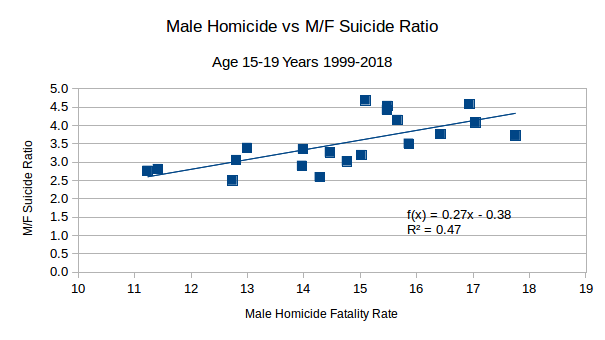Homicide and M/F Suicide Ratio
Note: this is part of the Youth Suicide Rise project.
We previously noticed that youth male homicide fatality rates are moderately correlated to youth suicide fatality rates, but that this relationship is not robust and does not hold for females.
Let us now look at the relationship of youth male homicide fatality rates with youth male to female suicide ratios:
We see that the linear correlation is moderate, but might be fairly robust:
The Crack Epidemic
It is important to keep in mind that the crack epidemic of the late 1980's led to a massive rise in youth homicides in the early 1990's as much of the drug trade was delegated to youth gangs.
Such a huge anomaly might disrupt a linear relationship, and in the latter period of 1999-2018 the linear correlation is indeed considerably higher (R squared close to 0.5). A further examination of the 1981-1998 period might also reveal stronger relationships once race and urbanity are taken into account.
1999-2018
Let us now look closer at the 1999-2018 period unaffected by the crack epidemic:
We have moderate correlation that does not seem to depend on any short period of time.
Let us now also look at the correlation with recent rates:
We see that the correlation increased considerably, suggesting that past trauma associated with male homicide tends to increase somewhat the M/F suicide ratio several years into the future.
Discussion
The simplest explanation would be that periods of rising male youth homicide increase male youth suicide -- but not female youth suicide -- and therefore increase the M/F youth suicide ratio.
It turns out, however, that there is a small negative correlation between male youth homicide and suicide 1999-2018:
We will examine this seeming paradox next.





No comments:
Post a Comment